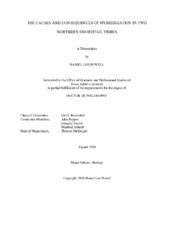| dc.description.abstract | Hybridization is a common phenomenon with important evolutionary consequences. It may result in the loss of genetic differentiation between groups, or serve to reinforce reproductive barriers between species. Hybridization may further allow for the introgression of adaptive traits from one species into another, aiding in the exploitation of novel niches. It may even contribute to the creation of new species. Much of the literature focuses on genotypes and phenotypes of individuals that have likely undergone many generations of selection because early generation hybrids are often rare in established hybrid zones. However, many important processes acting on hybrid fitness do so in the early stages of admixture. Thus, a crucial question is how selection acts on the first few generations of hybrids to determine the evolutionary trajectory of future generations. Natural selection on viability during the first generations of hybridization can be critical in shaping patterns of genetic exchange. In contrast, we know less about the evolutionary consequences of sexual selection during the early stages of hybridization, but genetic exchange between divergent populations ultimately depends on the mating decisions of individuals within sympatric populations.
My research addresses the causes and consequences of hybridization between two closely related swordtail fish, Xiphophorus birchmanni and X. malinche, in its early stages. I explore the fitness of the first two generations of hybrids when compared to parental species in a common-garden rearing experiment. I find little evidence for intrinsic fitness reduction, and hybrids were morphometrically and physiologically intermediate to parentals. Additionally, early generation female preferences were more permissive than either parental species and hybrid male chemical cues were universally attractive, circumstances that should promote ongoing geneflow between species via rampant back crossing. For gene flow between species via backcrossing and continued intercrossing to be possible however, there must first be a breakdown in reproductive isolation. I find that a common and deliberately introduced anthropogenic pollutant can not only disrupt chemical communication, but it does so in a way that should promote hybridization, causing female X. birchmanni to prefer the chemical cues of the heterospecific X. malinche over conspecific ones. Lastly, the ways in which hybridization can affect trait distributions in hybrid populations depends largely on the genetic architecture underlying those traits. I use controlled intercrosses to perform classical QTL mapping for many of these traits that exhibit correlated phenotypes within the two species. I uncover a single QTL for each of 5 separate traits, none of which colocalize to any one chromosome suggesting independent genetic pathways control these traits. As such, trait combinations might be expected to vary outside the distributions for either parental species in hybrid populations which aligns with patterns observed in the wild. | en |


